By Ajay Talwar
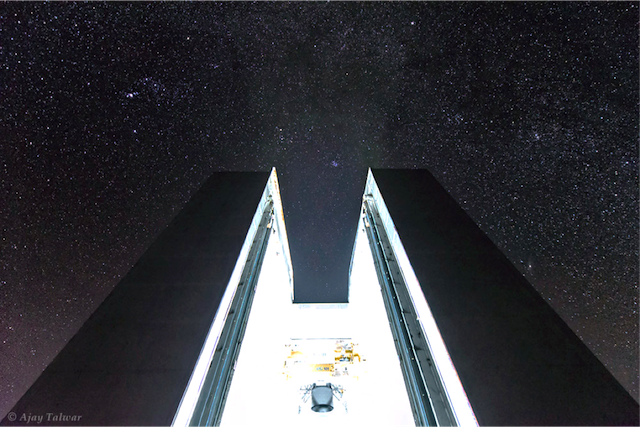 It is an exciting time for astronomy in India. Recently on 30th March 2016, a Telescope installed on top Devasthal Peak in the lower Himalayan was remotely switched on by the Prime Minister of India and Belgium from Brussels. The two countries have collaborated in designing and installing the telescope which happens to be the largest telescope in India.
It is an exciting time for astronomy in India. Recently on 30th March 2016, a Telescope installed on top Devasthal Peak in the lower Himalayan was remotely switched on by the Prime Minister of India and Belgium from Brussels. The two countries have collaborated in designing and installing the telescope which happens to be the largest telescope in India.
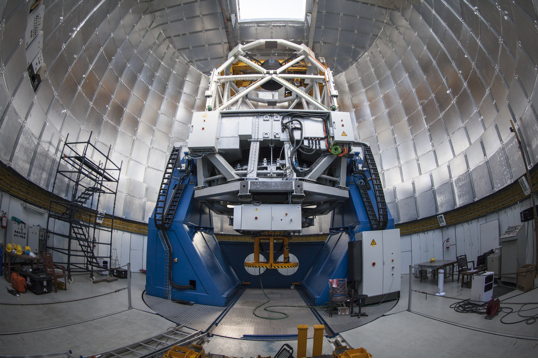 The telescope has automatically been christened as "DOT", Devasthal Optical Telescope. Devasthal peak is 2450 meters above sea level, in the Himalayas and is quite easily accessible, just 55km from the plains at Kathgodam and about 50 km from Nainital where ARIES, its parent institution, is situated.
The telescope has automatically been christened as "DOT", Devasthal Optical Telescope. Devasthal peak is 2450 meters above sea level, in the Himalayas and is quite easily accessible, just 55km from the plains at Kathgodam and about 50 km from Nainital where ARIES, its parent institution, is situated.
 The Devasthal peak is the highest in the region and is full of old trees, tall and majestic. Finding space for the various telescopes and other facilities has been a challenge for the engineers as well as for the environment. The 3.6 metre telescope has been built in an area surprisingly small for such a large telescope, in an effort to conserve the peak's environment. the mounting is altazimuth which helps in conserving space for the facility.
The Devasthal peak is the highest in the region and is full of old trees, tall and majestic. Finding space for the various telescopes and other facilities has been a challenge for the engineers as well as for the environment. The 3.6 metre telescope has been built in an area surprisingly small for such a large telescope, in an effort to conserve the peak's environment. the mounting is altazimuth which helps in conserving space for the facility.
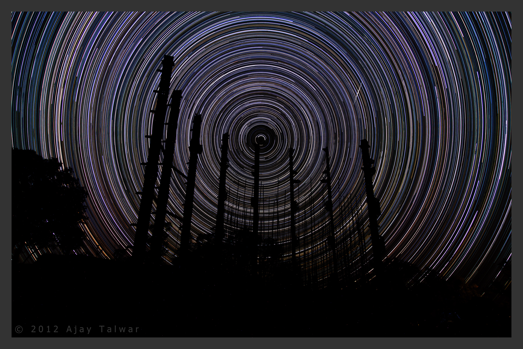 The facility has been under construction since a few years now. I have been lucky to have visited the site at various stages of construction. My first visit to the Devasthal was in MAy 2010 when the guest house and several accommodation for engineers were ready. Then in October 2012, I saw that a 1.3 metre telescope was complete and operational just below the peak. The Devasthal Peak had become an astronomical site. The work on the pillars of the observatory and the main pier for the telescope had started off.
The facility has been under construction since a few years now. I have been lucky to have visited the site at various stages of construction. My first visit to the Devasthal was in MAy 2010 when the guest house and several accommodation for engineers were ready. Then in October 2012, I saw that a 1.3 metre telescope was complete and operational just below the peak. The Devasthal Peak had become an astronomical site. The work on the pillars of the observatory and the main pier for the telescope had started off.
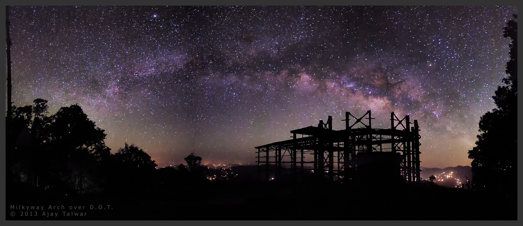 In my several visits to the observatory I saw progress of the observatory structure and the attached aluminising plant. It was an awesome feeling standing under the humongous structure akin to a big aeroplane hanger.
In my several visits to the observatory I saw progress of the observatory structure and the attached aluminising plant. It was an awesome feeling standing under the humongous structure akin to a big aeroplane hanger.
 Once I climbed on top of the construction to find a breath-taking panoramic view of the Himalayan Peaks at evening twilight. The peaks were bathed in the refracted red hues from the clear atmosphere, and the pink colour belt of Venus gained height from the horizon as the stars started to appear above. It was a magical hour that I spent on top of the construction. At the same time I noticed that the mental structure was inhumanly cold to touch, and the construction workers were continuously working in those conditions all over the construction site, and I must add, happily!
Once I climbed on top of the construction to find a breath-taking panoramic view of the Himalayan Peaks at evening twilight. The peaks were bathed in the refracted red hues from the clear atmosphere, and the pink colour belt of Venus gained height from the horizon as the stars started to appear above. It was a magical hour that I spent on top of the construction. At the same time I noticed that the mental structure was inhumanly cold to touch, and the construction workers were continuously working in those conditions all over the construction site, and I must add, happily!
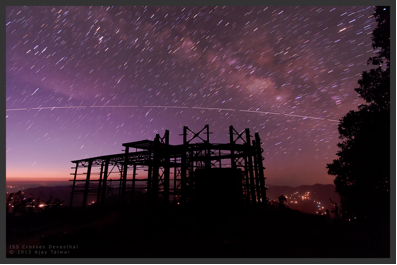 Here is a view of the construction of DOT in March 2013 with the International Space Station passing over.
Here is a view of the construction of DOT in March 2013 with the International Space Station passing over.
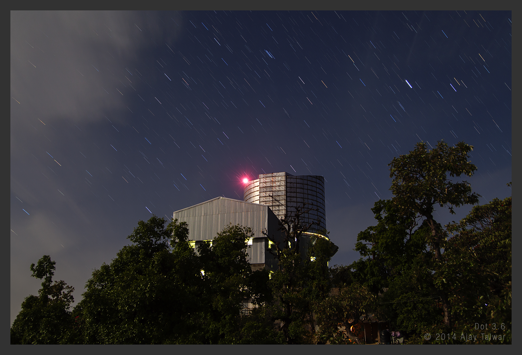 On my visit in December 2013 I saw the completion of the observatory enclosure and assembly and testing of telescope components was underway. Now, at present time, the Devesthal Optical Telescope is fully operational.
On my visit in December 2013 I saw the completion of the observatory enclosure and assembly and testing of telescope components was underway. Now, at present time, the Devesthal Optical Telescope is fully operational.
 Just nearby, work still continues on the 4 metre liquid mirror telescope. The telescope is larger, although it will only be able to 'look up' towards the zenith. The building housing the telescope seems tiny when you think of the large telescope that it will house, but the telescope need not move so the enclosure is small. (as image from 1 December 2013 looking eastwards at dawn from the site of the Liquid Mirror Telescope)
Just nearby, work still continues on the 4 metre liquid mirror telescope. The telescope is larger, although it will only be able to 'look up' towards the zenith. The building housing the telescope seems tiny when you think of the large telescope that it will house, but the telescope need not move so the enclosure is small. (as image from 1 December 2013 looking eastwards at dawn from the site of the Liquid Mirror Telescope)
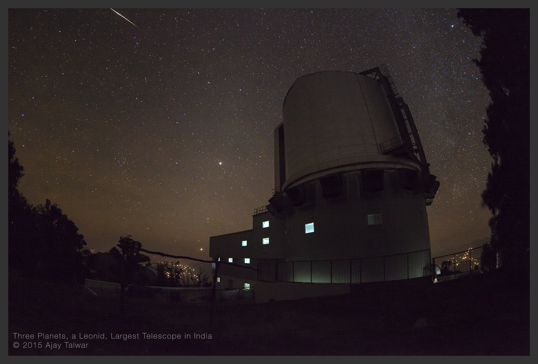 The completed Devasthal Optical Telescope, the largest telescope in India.
The completed Devasthal Optical Telescope, the largest telescope in India.
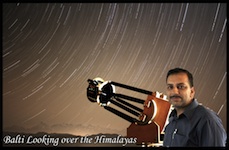 Ajay Talwar took up astrophotography in 1987 during a night when the Moon was occulting the Pleiades. Since then he has continued photographing the skies passionately. He is the most prolific transient sky events photographer in India. One of his early accomplishments was to produce an exhibition of all Messier objects along with three other Indian astrophotographers. Ajay travels with all his astrophotography gear to all across India, especially the Himalayas, places like high altitude Indian Astronomical Observatory at Hanle, Ladakh, high peaks in Himachal Pradesh. His interest to dark skies also take him to the white desert in the northwestern India.
Ajay Talwar took up astrophotography in 1987 during a night when the Moon was occulting the Pleiades. Since then he has continued photographing the skies passionately. He is the most prolific transient sky events photographer in India. One of his early accomplishments was to produce an exhibition of all Messier objects along with three other Indian astrophotographers. Ajay travels with all his astrophotography gear to all across India, especially the Himalayas, places like high altitude Indian Astronomical Observatory at Hanle, Ladakh, high peaks in Himachal Pradesh. His interest to dark skies also take him to the white desert in the northwestern India.
Ajay Talwar regularly holds astrophotography workshops, including practical programs in the Himalayas where participants are provided necessary equipment to photograph the sky.
India is an enormous country of natural and cultural diversity. Through his TWAN contribution Ajay hopes to photograph many of India's heritage under the starry sky.
Ajay is blurring the sharp divide between scientific astrophotography and artistic photo-journalism. In 2011 he was invited to attend a month long residency by the Khoj International Artist’s Association. At the end of ‘Shifting Focus’ his work was exhibited at the Khoj Studios, New Delhi.







